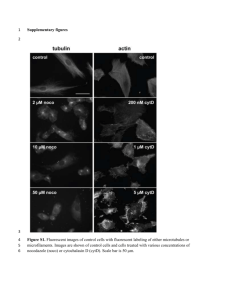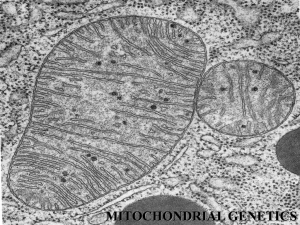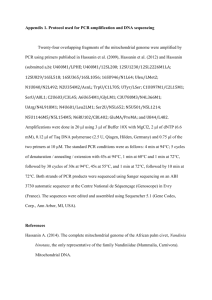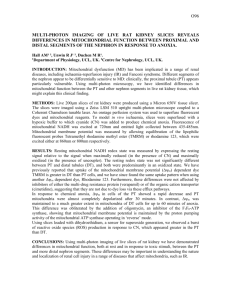Metabolism toxins and diseases research
advertisement
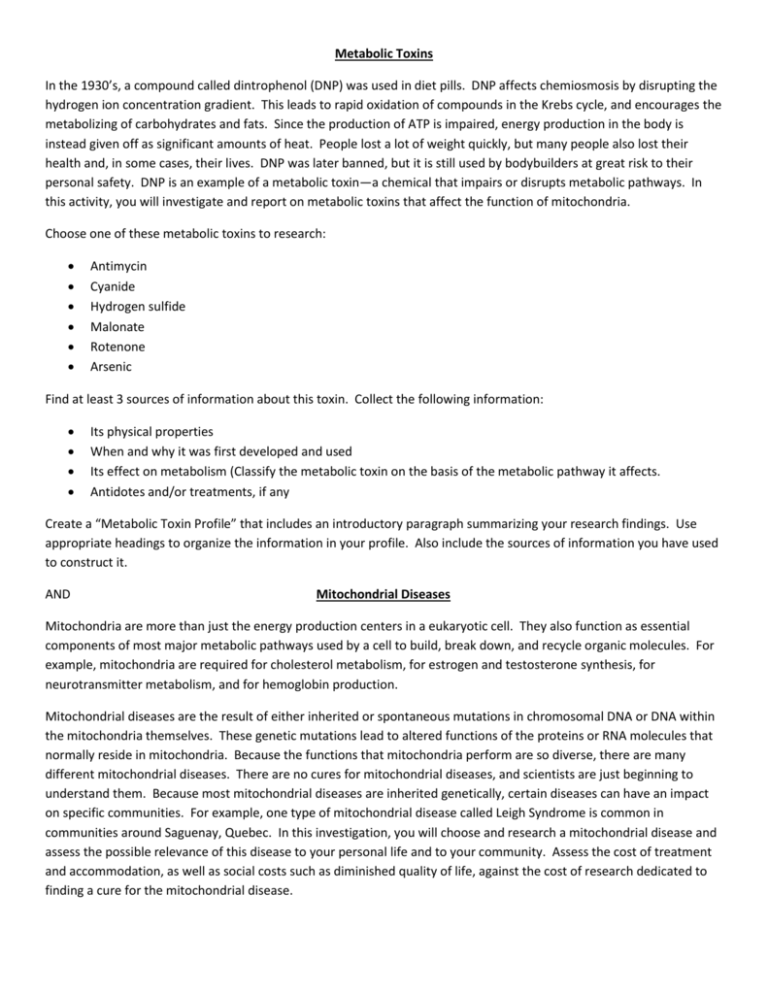
Metabolic Toxins In the 1930’s, a compound called dintrophenol (DNP) was used in diet pills. DNP affects chemiosmosis by disrupting the hydrogen ion concentration gradient. This leads to rapid oxidation of compounds in the Krebs cycle, and encourages the metabolizing of carbohydrates and fats. Since the production of ATP is impaired, energy production in the body is instead given off as significant amounts of heat. People lost a lot of weight quickly, but many people also lost their health and, in some cases, their lives. DNP was later banned, but it is still used by bodybuilders at great risk to their personal safety. DNP is an example of a metabolic toxin—a chemical that impairs or disrupts metabolic pathways. In this activity, you will investigate and report on metabolic toxins that affect the function of mitochondria. Choose one of these metabolic toxins to research: Antimycin Cyanide Hydrogen sulfide Malonate Rotenone Arsenic Find at least 3 sources of information about this toxin. Collect the following information: Its physical properties When and why it was first developed and used Its effect on metabolism (Classify the metabolic toxin on the basis of the metabolic pathway it affects. Antidotes and/or treatments, if any Create a “Metabolic Toxin Profile” that includes an introductory paragraph summarizing your research findings. Use appropriate headings to organize the information in your profile. Also include the sources of information you have used to construct it. AND Mitochondrial Diseases Mitochondria are more than just the energy production centers in a eukaryotic cell. They also function as essential components of most major metabolic pathways used by a cell to build, break down, and recycle organic molecules. For example, mitochondria are required for cholesterol metabolism, for estrogen and testosterone synthesis, for neurotransmitter metabolism, and for hemoglobin production. Mitochondrial diseases are the result of either inherited or spontaneous mutations in chromosomal DNA or DNA within the mitochondria themselves. These genetic mutations lead to altered functions of the proteins or RNA molecules that normally reside in mitochondria. Because the functions that mitochondria perform are so diverse, there are many different mitochondrial diseases. There are no cures for mitochondrial diseases, and scientists are just beginning to understand them. Because most mitochondrial diseases are inherited genetically, certain diseases can have an impact on specific communities. For example, one type of mitochondrial disease called Leigh Syndrome is common in communities around Saguenay, Quebec. In this investigation, you will choose and research a mitochondrial disease and assess the possible relevance of this disease to your personal life and to your community. Assess the cost of treatment and accommodation, as well as social costs such as diminished quality of life, against the cost of research dedicated to finding a cure for the mitochondrial disease. Pre-lab Questions 1. 2. 3. 4. What vital functions do mitochondria carry out in a major organ such as the liver? What do you think might be the level of awareness among Canadians of the occurrence of mitochondrial diseases? Do you think doctors find mitochondrial diseases easy or difficult to diagnose? Why? How might a community be affected by the high incidence of a mitochondrial disease in the population? Question What are the effects of a particular mitochondrial disease on energy production and metabolism, and how can you assess the relevance, to your personal life and to the community, of an understanding of mitochondrial diseases? Conduct research into the causes, symptoms, treatments, and costs associated with the particular mitochondrial disease you have chosen to investigate. (Advocacy groups such as Mitoaction in Canada and United Mitochondrial Disease Foundation in the United States have posted a wealth of information about many mitochondrial diseases on their websites.) Focus your research on the following questions How common is the mitochondrial disease? Is the disease an inherited condition or the result of genetic mutation? (If it is the latter, what do researchers believe causes the mutation?) What part of the mitochondrion is affected, and how does that affect the energy and metabolism, and, more broadly, the organs or biological systems of a person who has the disease? What are the symptoms of the disease? What treatments are available to manage the symptoms of the disease? Are the treatments comparatively inexpensive (for example vitamin supplements) or comparatively expensive (for example specialized medications)? How much do existing treatment methods cost per patient, per year? Approximately how much would the total treatment cost be for the entire Canadian population that is affected by this disease? Are there accommodative devices, such as wheelchairs, that people with the mitochondrial disease will need as their condition advances? How much do these devices cost? Does your community have existing infrastructure to accommodate people with mitochondrial disease (for example wheelchair ramps, accessible washrooms, suitable places for rest)? How might the disease affect a person’s quality of life or ability to study or work? Do the treatments themselves have side effects that can result in social or economic costs? What is the cost of current research dedicated to finding improved treatments and a possible cure for the mitochondrial disease you have chosen to investigate? Based on analyzing the information you gathered, make a recommendation as to whether or not research in to the disease should continue. Communicate your findings in a format that you think would be most effective in raising awareness of the mitochondrial disease and the social and economic costs associated with it. Adapted from McGraw-Hill Ryerson Biology 12 ©2011 McGraw-Hill Ryerson Ltd.




